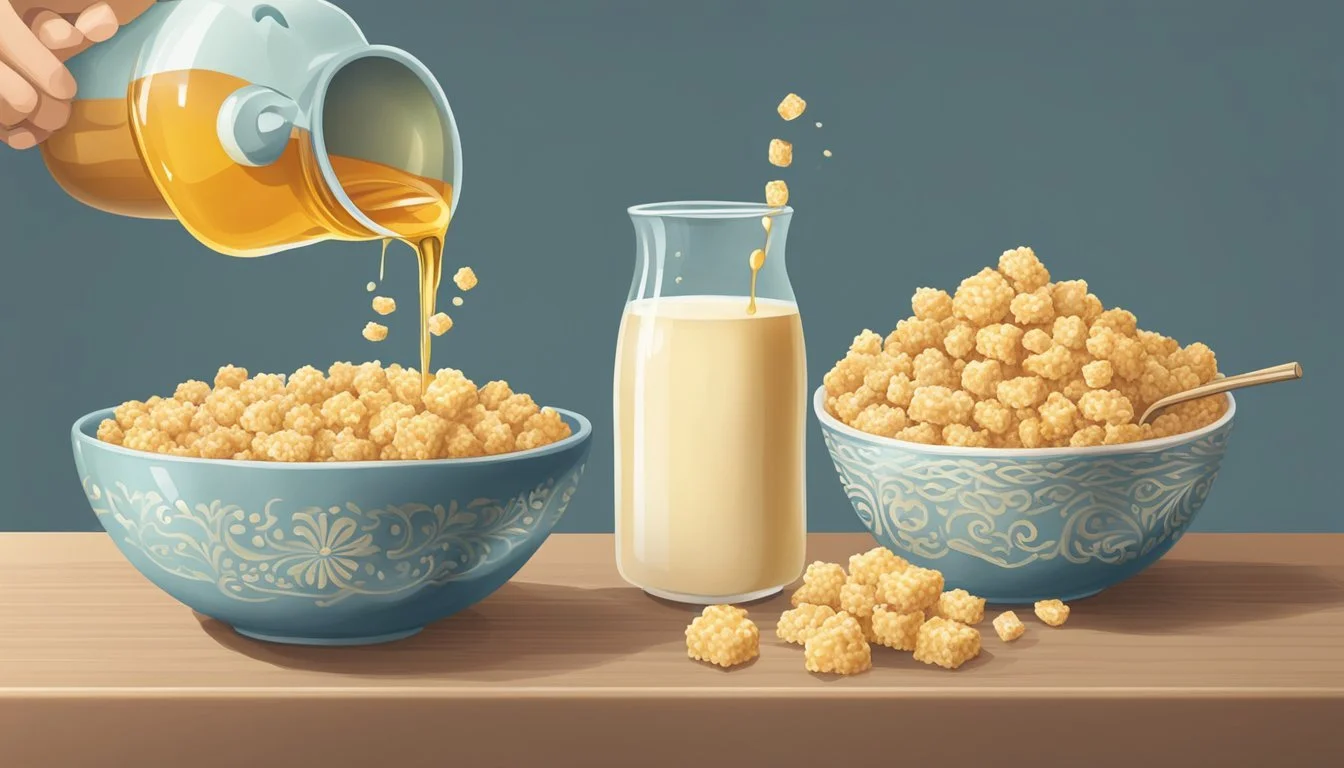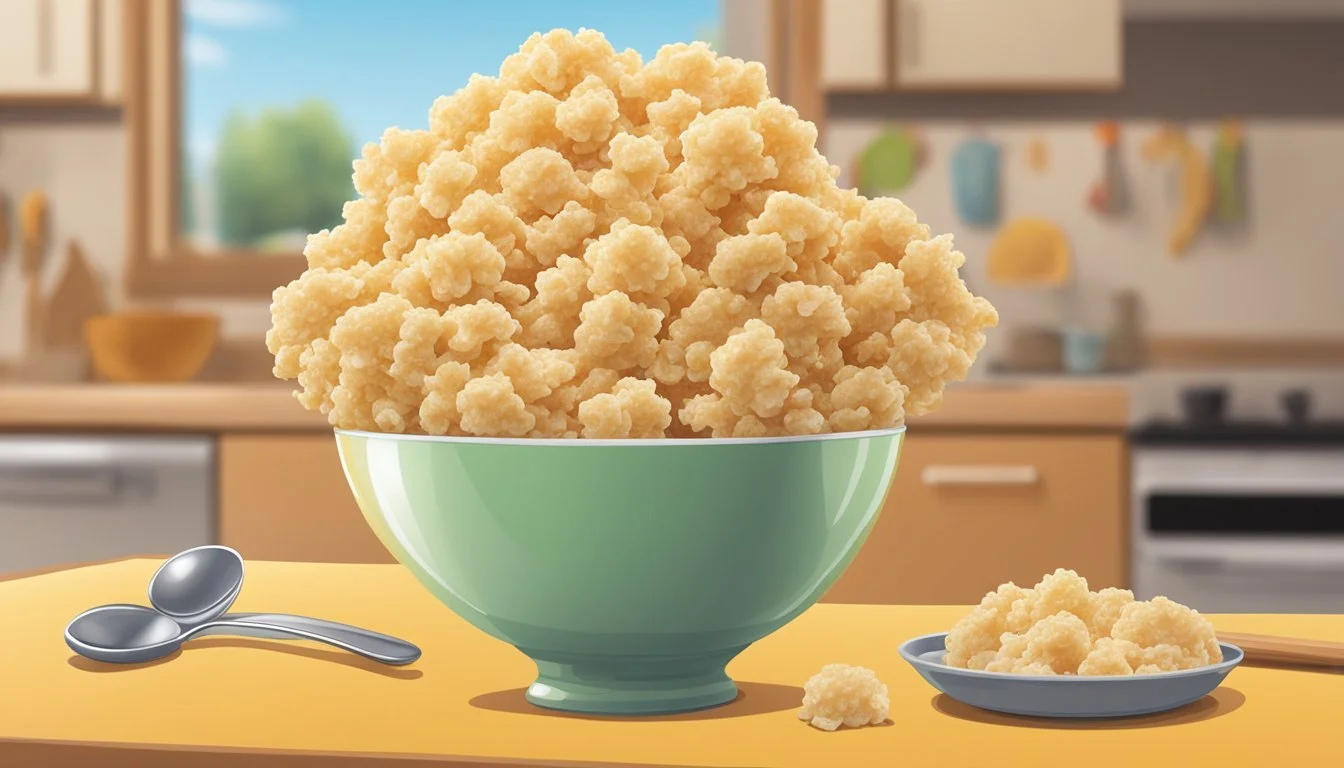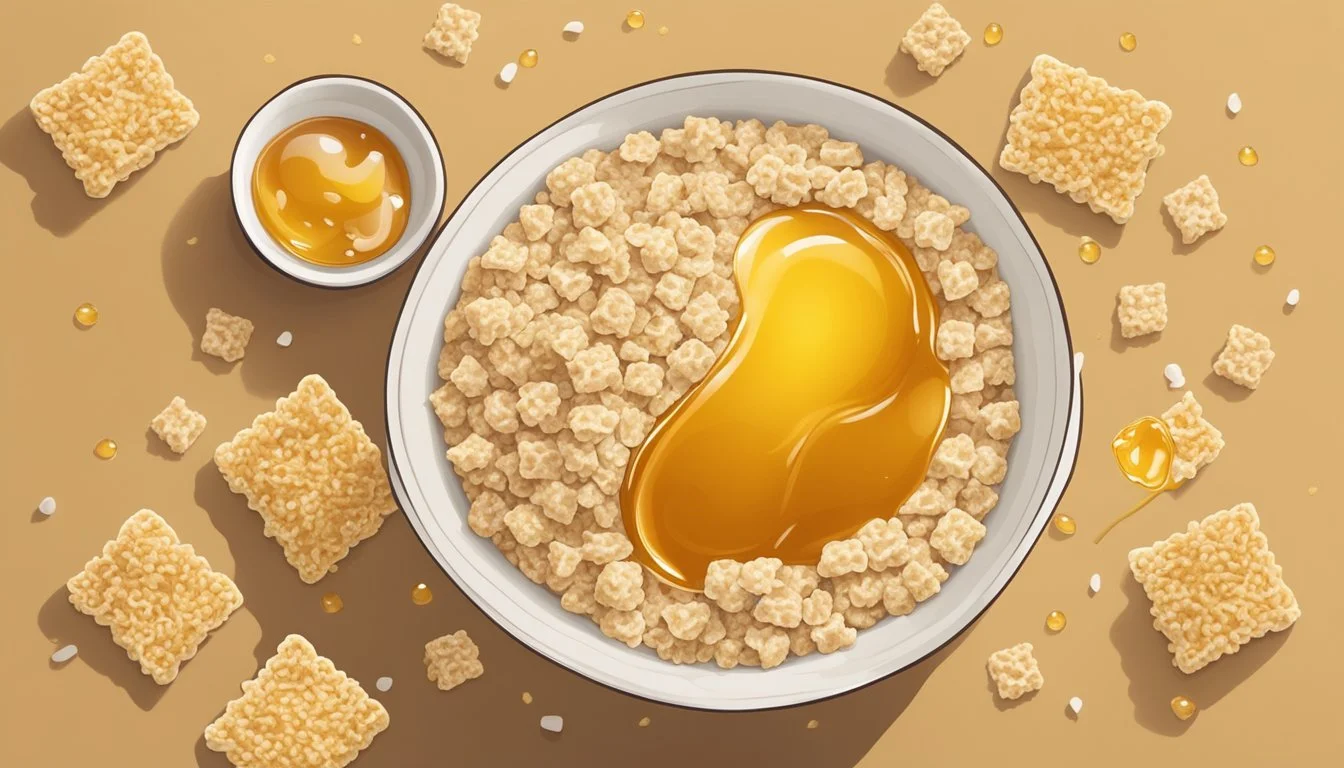Honey Ohs! vs Rice Krispies
Comparing Nutrition and Flavor
This Article is Part of Our Breakfast Cereal Guide with Details on Honey Ohs! Nutrition and Rice Krispies Nutrition
For cereal enthusiasts and health-conscious individuals, the classic debate of Honey Ohs! vs. Rice Krispies often brings up questions of health and taste. Honey Ohs!, known for its sweet, honey-flavored rings, offers 12 grams of complex carbohydrates per serving while Rice Krispies provide a higher count with 22 grams. This distinction often leads to a deeper contemplation about which of these breakfast staples packs a healthier punch.
When it comes to sugar content, Honey Ohs! contain 11 grams of sugars per serving compared to Rice Chex's mere 2 grams. While this may suggest Honey Ohs! has a more indulgent flavor, it’s also important to consider the nutritional trade-offs such as fiber content and overall dietary impact. For those looking to reduce sugar intake, Rice Krispies may be the preferable choice despite their plainer taste profile.
Taste remains a personal preference, with Honey Ohs! offering a distinct honey sweetness and crunch that many find satisfying. Rice Krispies provide a more neutral base, often enhanced by adding fruits or other toppings. This versatility makes Rice Krispies a flexible option for diverse breakfast routines. Balancing flavor and health benefits depends on individual dietary goals and taste preferences.
Nutritional Profile
When comparing Honey Ohs! and Rice Krispies, it's important to examine their caloric content, macronutrient composition, and vitamins and minerals.
Caloric Content
Honey Ohs! contains 170 calories per serving of one cup (40 grams). Rice Krispies, being a lower-calorie option, provides around 130 calories per 1 1/4 cup serving. This makes Rice Krispies a lighter option calorically, suitable for those monitoring their intake.
Macronutrients
Protein:
Honey Ohs!: Less than 1 gram of protein per serving.
Rice Krispies: About 2 grams of protein per serving.
Fat:
Honey Ohs!: Contains 3 grams of fat per serving, with 0 grams of saturated fat.
Rice Krispies: Contains 0 grams of fat.
Fiber:
Honey Ohs!: Offers 1 gram of dietary fiber.
Rice Krispies: Typically contains less dietary fiber.
Sodium:
Honey Ohs!: 220 milligrams of sodium per serving.
Rice Krispies: Higher at 290 milligrams of sodium per serving.
Minerals and Vitamins
Calcium:
Honey Ohs!: Provides a moderate amount.
Rice Krispies: Less notable in calcium content.
Iron:
Honey Ohs!: Contains iron, crucial for oxygen transport in the blood.
Rice Krispies: Also fortified with iron, enhancing metabolic processes.
Vitamin B6:
Honey Ohs!: Includes some B vitamins like B6.
Rice Krispies: Typically fortified with several B vitamins, including B6.
Potassium and Zinc:
Honey Ohs!: Offers potassium, an essential mineral for effective cellular function.
Rice Krispies: Generally lower in potassium but contains zinc, beneficial for the immune system.
In summary, the choice between Honey Ohs! and Rice Krispies comes down to individual nutritional priorities, be it calorie control, macro balance, or specific vitamins and minerals.
Comparison by Ingredients
Honey Ohs and Rice Krispies differ significantly in their primary ingredients, sugar content, healthy fats and oils, and flavor enhancers. Understanding these differences can help in making a more informed choice between these cereals.
Primary Ingredients
The primary ingredients in Honey Ohs! include whole grain oats, rice, and corn. These grains are well-known for their health benefits and add a chewy texture to the cereal.
On the other hand, Rice Krispies are primarily made from crisped rice, which consists of rice and sugar. The rice adds a light, airy texture and a mild flavor.
The differences in primary ingredients impact the cereal's texture and nutritional profile. Honey Ohs! offers more whole grains, while Rice Krispies focus on simplicity with a single primary ingredient.
Sugar Content
Sugar content is a crucial consideration. Honey Ohs! contains multiple forms of sugar, such as honey, brown sugar, and added sugars, contributing to its total sugar content of approximately 9 grams per serving.
Rice Krispies have a lower sugar content, at about 4 grams per serving. The primary sources of sugar in Rice Krispies include corn syrup and sugar.
Given the difference in sugar content, those monitoring their sugar intake might prefer Rice Krispies.
Healthy Fats and Oils
When it comes to healthy fats and oils, Honey Ohs! contains a small amount of fats, primarily derived from canola oil and coconut oil. Each serving has around 2 grams of total fat, with negligible saturated and no trans fats.
Rice Krispies have a minimal fat content, with 0 grams of fats per serving. This makes them suitable for those looking to reduce fat intake.
For those interested in heart-healthy fats, Honey Ohs! provides a bit more, though not significantly.
Flavor Enhancers
Honey Ohs! makes use of natural flavor enhancers such as honey and brown sugar, which give it a sweet and rich flavor profile. Additionally, these ingredients provide a golden color and appealing aroma.
Rice Krispies rely on simplicity, with salt and a small amount of artificial flavor to enhance the taste. The light and crunchy texture is their main appeal, complemented by a subtle sweetness from corn syrup.
Flavor preferences between the two will largely depend on whether one enjoys the richer taste of honey or the lighter, simpler flavor of rice.
Types of Diets Accommodated
Understanding how Honey Ohs! and Rice Krispies fit into various dietary plans is crucial. These cereals cater differently to gluten-free diets, vegan lifestyles, weight management goals, and fortified nutrient needs.
Gluten Considerations
Rice Krispies are naturally gluten-free, making them suitable for those with celiac disease or gluten sensitivity. However, always check the packaging to ensure there is no cross-contamination during processing.
Honey Ohs!, on the other hand, typically contain gluten, which can be problematic for those with gluten-related disorders. If avoiding gluten is essential, Rice Krispies is the safer choice.
Vegan Varieties
Rice Krispies may pose issues for vegans due to ingredients like sugar and vitamin D3, which can be derived from animal sources. Sugar in many regions is processed using bone char, and vitamin D3 often comes from lanolin.
For those adhering strictly to vegan principles, Honey Ohs! are a less favorable option, as they include honey, an animal-derived ingredient. It’s always best to consult ingredient labels to ensure compliance with vegan dietary restrictions.
Weight Management
For individuals focused on weight management, both cereals offer different advantages. Rice Krispies are typically lower in calories per serving, making them a favorable choice for those monitoring caloric intake.
Honey Ohs! provide more dietary fiber and protein, which can promote satiety and help with hunger management. Depending on the diet plan, either option can fit well, but it's important to consider additional nutritional elements like sugar content and fiber.
Fortified Options
Both Honey Ohs! and Rice Krispies are fortified with essential vitamins and minerals. Fortification helps in meeting daily nutrient requirements, especially for people on restricted diets that might lack certain nutrients.
Rice Krispies often boast higher levels of added B vitamins and iron, while Honey Ohs! may contain more fiber and additional minerals. Evaluating the fortification profile can help in choosing the cereal that aligns better with individual nutritional needs.
Consumer Information
Consumers looking for breakfast options such as Honey Ohs! and Kellogg's Rice Krispies will benefit from understanding detailed information on branding, serving size recommendations, and nutritional facts. This section provides specific insights to aid in making informed choices.
Brand and Manufacturer
Honey Ohs! is produced by Quaker Oats, a well-known cereal manufacturer. This brand fits into the segment of cereals known for their taste and nutritional balance.
Kellogg's Rice Krispies, on the other hand, come from Kellogg's, another reputable giant in the cereal industry. Known for their classic snap, crackle, and pop, Rice Krispies have been a staple breakfast choice for years.
Both brands have strong market presence and trust, reflected in their widespread availability in stores.
Serving Size Recommendations
For Honey Ohs!, each serving size is one cup, equivalent to 40 grams. The box typically contains seven servings. This serving provides a manageable portion for those watching their calorie intake.
Kellogg's Rice Krispies come in a serving size of 1 1/2 cups, which translates to 33 grams. The typical box offers several servings, aligning with many dietary guidelines.
Serving sizes for cereals like Cheerios and Honey Smacks also fall within a similar range, ensuring portion control for consumers.
Labeling and Nutrition Facts
Honey Ohs! nutritional facts per serving include:
Calories: 170
Total Fat: 3g (4% DV)
Saturated Fat: 0g (0% DV)
Sugars: Not specified in the provided data
For Rice Krispies:
Calories: Varies by type but generally low
Fiber: 0g (noteworthy absence)
Total Sugars: Varies, important to check specific box
Consumers are advised to examine the packaging for allergens and specific nutritional content such as cholesterol, fats, and total sugars, aiding in making choices that align with their health goals and dietary needs.
Comparing different popular cereal brands and understanding their nutrition facts help in making personalized dietary decisions, crucial for maintaining balanced eating habits.
Usage in Recipes
Honey Ohs! and Rice Krispies have distinct textures and flavors, making them versatile and popular choices for a variety of recipes. These cereals can be used in classic preparations, creative variations, and healthy alternatives, each offering quick, easy, and delicious results.
Classic Preparation
Rice Krispies Treats are the go-to recipe for using Rice Krispies cereal. Traditionally, you need 3 ingredients: butter, marshmallows, and crispy rice cereal.
Melt the butter in a large pan over low heat, then add the marshmallows, stirring until melted. Remove from heat and mix in the cereal until well-coated. Press the mixture into a greased baking pan and let it cool.
Honey Ohs! can be substituted for Rice Krispies in similar basic marshmallow-based recipes, adding a honey-flavored twist.
Creative Variations
Creative cooks have expanded on the traditional treats, incorporating ingredients like peanut butter, chocolate, and vanilla. Peanut Butter Honey Rice Krispie Treats mix peanut butter and honey with the cereal, yielding rich, protein-packed snacks.
Birthday cake and cookie dough variations add sprinkles and chocolate chunks for festive favorites.
Utilize Honey Ohs! in a delectable recipe for Honey Ohs! marshmallow clusters or blend it into dessert bars layered with chocolate and natural sugar.
Healthy Alternatives
For those seeking healthier options, recipes often swap out marshmallows for honey or other natural sweeteners. Healthy Rice Krispie Treats might use honey, sunflower butter, and a dash of vanilla paste. A common method involves mixing these ingredients in a pan, combining them with the cereal, and pressing them into a parchment-lined square pan.
High-protein versions may incorporate whey protein powder or peanut butter for an extra nutritional boost. Opting for flavored cereals like Honey Ohs! in recipes can also provide a natural sweetness, reducing the need for added sugars.







